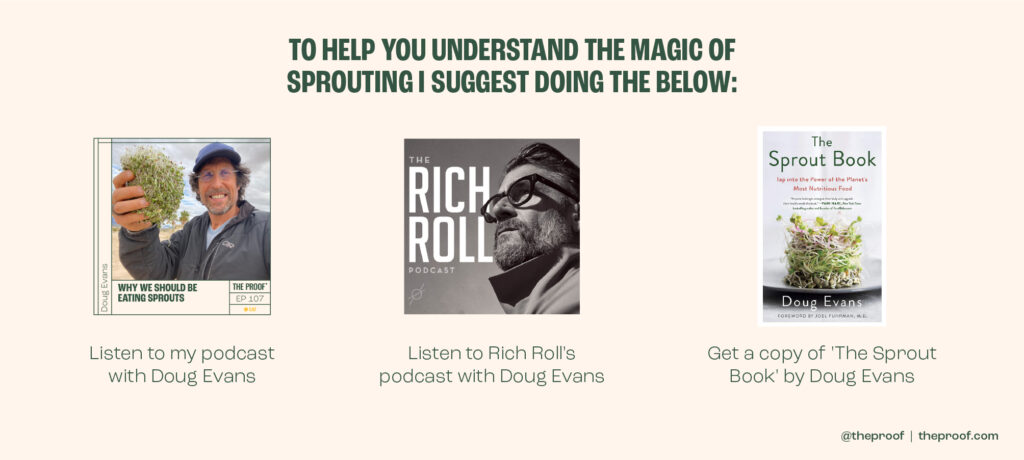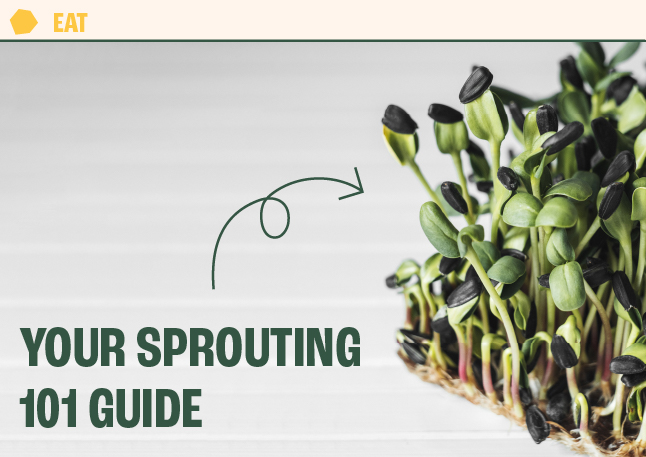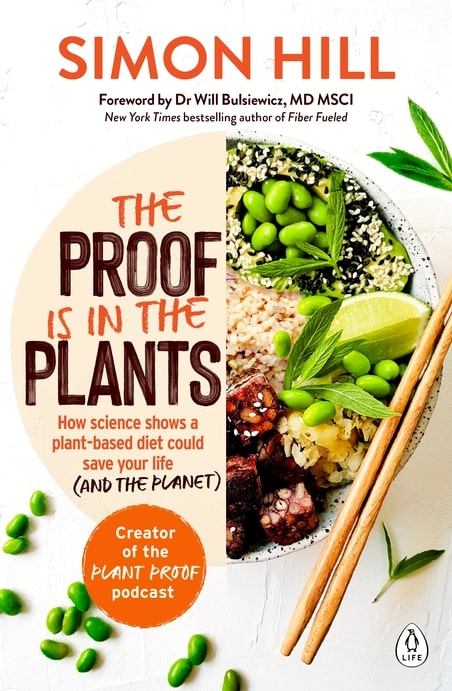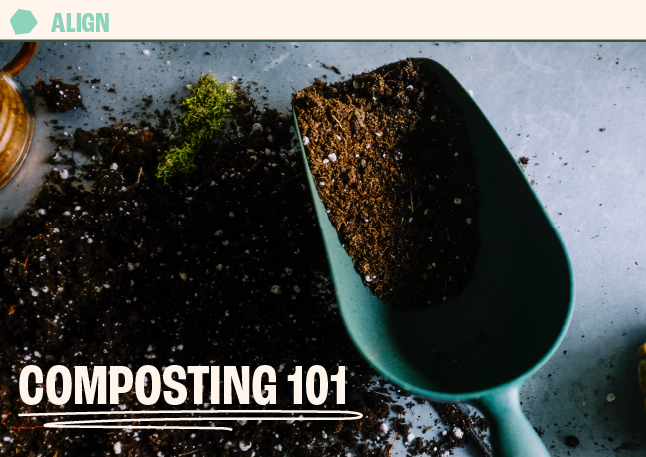Hi friends. As you know, one of my favourite things to do is pass on practical information that’s easy to implement, backed by science, and most of all will help you upgrade your health. I hope the information in this blog will help you do exactly that.
Sprouting 101
While this is more of a ‘Sprouts 101’ blog I also had in mind those who may already be sprouting, so if that’s you please do continue reading and I am sure you will pick up an extra tip or two that will help your sprouting game.
Now before we get into the nitty gritty of sprouts I do want to thank someone for inspiring this entry. That thank you goes to Doug Evans who kindly sent me his incredible book ‘The Sprout Book’ and joined me on the podcast for what was a really enlightening conversation that centred on the magical benefits of sprouting (you can listen to that here).
So how does one dip their toes into the world of sprouts. Well, to help you with that here’s my 4 tips. Like anything it starts with a little bit of learning and then you need to put that learning into action. Trust me this is fun, I really can’t wait for you to get started.
4 tips to starting to sprout seeds
1 – Read the rest of this blog
2 – Listen to my podcast with Doug.
3 – Doug was also recently on Rich Roll’s show who has been on the Plant Proof Podcast a few times and is a good friend of mine. So please do checkout that episode too. I’m positive after both of these episodes you are going to be absolutely pumped to begin sprouting, and armed with the information to do so.
4 – Get a copy of Doug’s book (Australian’s buy here) and buy your equipment and seeds from a local company near to you (I have listed a few suggested companies – none of which I have any affiliation with whatsoever).

What is sprouting?
One of the most common sprouts that you are likely to have come across in your local supermarket is alfalfa. Essentially, sprouts are baby plants. When you expose seeds to the right moisture and temperature they begin to ‘germinate’ and grow, starting with a shoot and then leaves.
Why sprout?
Even though sprouts are ‘baby plants’ they are incredibly nutrient dense and low in calories. In a world where a lot of the population is overweight, yet undernourished, sprouts are the perfect addition to one’s diet. For example, just 1 cup of sprouted lentils is only 80 calories, yet provides 7 grams of protein, 20% of daily folate, 14% of daily iron (31% for men) and 21% of Vitamin C. These are by far one of my favourite sprouts!
You may be thinking, but why no just eat lentils, flaxseeds or broccoli as one would normally? Firstly, I’m certainly not saying you need to remove all of these foods from your diet and only eat sprouts. But I do want you to add sprouts into your weekly regime wherever you can. Why? Because, during the sprouting process a few magical things take place that I don’t want you to miss out on:
1 – Certain nutrients, particularly essential minerals like calcium, become more ‘bioavailable’ during sprouting. By bioavailable I mean they transform in a way where they can be better utilised by the body. Rather than calcium your body cannot digest and make use of, more calcium is available for the body to absorb and put to work. You’ve probably heard me before talking about soaking and cooking dry beans, which helps break down phytic acid, oxalates and lectins (none of these are to be feared by the way) – both of those processes also help increase bioavailability of nutrients. You can think of sprouting as an extra tool in your toolbox to further break down these compounds, increase the bioavailability of the nutrients in your food, and improve your digestion. For example, sprouting soybeans breaks down lectins by 57%.
I want to be clear – I don’t want you to fear phytates, oxalates and lectins. I often compare them to oxygen. If we breathe 100% oxygen for too long we die. At this concentration oxygen is toxic. However, oxygen in the concentration it’s found in air, is health promoting. And the same goes for phytates, oxalates and lectins. As long as you aren’t eating dried raw beans (which would taste terrible and hurt your teeth) they are not something to stress about. After all, legumes contain all 3, and have been shown to be the single greatest dietary predictor of longevity, and are regular consumed in all blue zones (longest living populations in the world).
2 – Compared to the seed, sprouts often contain greater amounts of nutrients, including amino acids (the building blocks of protein). In fact , sprouting soybeans results in 7% greater protein in soy milk and 13% greater protein in tofu, compared to their regular forms.
Think of it like this. Grains, legumes, nuts and seeds are already some of the healthiest foods on the planet! By sprouting them you make them even more powerful.
3– Sprouting seeds may make them easier for you to digest! If you are trying to eat a more whole food plant-based diet, and are not accustomed to high fibre whole plant foods, you may experience some discomfort, bloating and/or gas when you begin eating this way. That’s entirely normal. Rather than being turned off for good, and reverting to your old diet, it’s nice to have some tools in the toolbox to help make your transition smoother. I always recommend looking at your portion sizes – if you’ve gone from eating barely any legumes to eating them by the cup, chances are you are just overwhelming your gut. Give it time to adjust by reducing the portion size and slowly building up over a period of months. Sprouting can also help you with this. By essentially telling the seed “it’s time to sprout” (what the soaking/spraying does) we provoke the seed to release certain enzymes that begin to break down certain nutrients, into the building blocks that it requires to build plant. Inadvertently, this ‘pre-digestion’ also makes these nutrients more available to us (described above), so when we harvest the sprouts (we tricked the plant into think it would grow into a big plant) some of the digestion is already done for us.

What equipment do you need to get started?
While there is a wide variety of gear you can get here’s a few things that will get you going:
1 – Glass sprouting jars
- Sprout People (USA)
- Australian wheatgrass (Australia)
- Sprout Australia (Australia)
2 – Glass spray bottle
- These are available widely across the world so it’s best to source something local to you like this. Ideally, food grade and BPA free.
3 – Unbleached paper towel
Comes in handy for sprouting certain seeds on the ceramic tray. Also good for pat drying sprouts before putting in the fridge.
- Sprout People (USA)
- Australian wheatgrass (Australia)
4 – Sprouting tray
For sprouting flaxseeds and other seeds that you don’t soak but spray instead
- Skippy Grain Mill’s (Australia)
- Etsy (USA and free shipping to Australia)
- Also on Etsy (USA and free shipping to Australia)
5 – Seeds
(I recommend starting with broccoli seeds, flaxseeds and a legume like lentil seeds). Choose organic when you can – this is one of the advantages of growing your own sprouts versus buying store bought ones which are often not organic.
- Sprout People (USA)
- Australian wheatgrass (Australia) (Big range of seeds and bulk options up to 25Kg available)
- Sprout Australia (Australia) (Organic broccoli seeds priced at just 60 cents a serve when you buy 1Kg and they offer Free Shipping which is a bonus)
How to choose the right seeds?
Ideally you want seeds that are:
- Clearly sold as seeds for sprouting. If you buy dried legumes or nuts off the shelf chances are they are not going to germinate and are far more likely to contain harmful bacteria.
- Certified organic
- Where possible locally sourced from your country. Although what you eat is considerably more important than how far it travels when it comes to sustainability, to lower the environmental footprint of your home grown sprouts even further, try and buy local origin seeds.
- Have a high germination rate (they should tell you this if they are being sold as seeds dedicated for sprouting). Anything close to 90% is good. This essentially tells you what percentage will turn into sprouts.
- Have been washed to reduce the risk of them carrying any harmful bacteria
A Sprouts Journey
As Doug says, each sprout has it’s own journey. In his book you can find information on sprouting all sorts of different nuts, seeds, legumes and grains but here I’ll share with you two of my favourite’s so you get the gist:
1 – Broccoli Sprouts
- Place in a sprouting jar (approx. 1/4 of cup), give them a rinse and then soak for 8 hours. After 8 hours drain and rinse the seeds. Now the soaking period is done for the next 3-5 days you are just going to rinse them at least 2 times per day. If it’s warmer weather rinsing them more often may help them germinate. Each time after rinsing them returning them to sit on an angle so they can drain (into a tray or bowl to avoid a mess). This rinsing process ensures the sprouts have adequate moisture to germinate and also helps remove waste products. As the days go past you will see them come to life. The yield on broccoli sprouts is 16x the original seed volume. Start with 1/4 of a cup and you’ll get 4 cups of broccoli sprouts to enjoy. I’ve been putting them in my smoothie, in my salads and have even been giving them to my dogs Gnocchi & Giuseppe (yes, they are completely safe for dogs).

2 – Flaxseeds
- Unlike broccoli seeds, and many other seeds, to sprout flaxseeds you do not need to soak them. Instead, it is best to sprout flaxseeds by first placing them onto a sprouting tray that is lined with unbleached paper towel. Be careful not to place too many seeds on the towel so it’s a thin layer as opposed to layers and layers stacked on top of one another. Next, using the glass spray bottle, spray the seeds, until damp, with filtered water (careful not to get them too wet). One hour later spray again and then repeat the spraying process 2-3x per day for 5-7 days until they have all sprouted with little white tails (sometimes by day 7 they will get little leaves, particularly if you transfer them to a jar and place near the sun). Perfect on your morning oats, in your smoothie or just grab a handful and simply enjoy on their own.
Storing your sprouts
Storing your sprouts correctly is really important for keeping them fresh and free of harmful bacteria such as Salmonella and E.Coli. Firstly, you always want to give them a final rinse in water before leaving out to air dry for 8-12 hours. You do not want to be putting damp sprouts into the fridge – that’s a recipe for bacterial contamination. It’s also important to be careful handling your sprouts. Make sure you hands are always very clean or you could easily introduce bacteria into them that under the right conditions is able to proliferate.
To play it safe I personally like to eat my sprouts within 1-2 days of harvesting them and putting them in the fridge. Ideally to keep them fresh, without drying them out, you want to store in some form of Tupperware that is not air tight. But really this is only super important if you are storing them for a long time (they can stay fresh up to a few weeks if stored correctly). But to be honest, I prefer making smaller batches and consuming them within a few days because that way I know the risk of contamination (providing your little hands are clean and you buy sprout grade seeds) is super low.
Each time you remove sprouts again make sure your hands, or the utensils you use are clean. And then give them a good rinse under water before consuming.
Eating your sprouts – raw or cooked?
Cooked:
Children, pregnant women, elderly and any one who is immune compromised should thoroughly cook their sprouts before consuming. this is because of the risk of contamination.
Raw:
Raw or lightly cooked sprouts should only be consumed by healthy, non-pregnant adults. Of course, if that’s you and you still feel like erring on the side of caution – it’s good to know that sprouts are still very nutritious when cooked.
The benefits far outweigh the risks:
While this risk of contamination is certainly real, I don’t want to put you off sprouts all together! In fact, omnivores, are far more likely to pick up Salmonella for example, from various animal products such as chicken. Furthermore, food poisoning from sprouts is very rarely life threatening and typically symptoms such as abdominal cramps, diarrhoea and vomiting go away between 12-72 hours. As the Academy of Nutrition & Dietetics say the benefits of sprouts far outweigh the risks. So please don’t let this turn you off the magical world of sprouting – it is just something to be mindful of!
The sprout challenge
Long time listeners of the show, and those who follow me on social media, will be well aware of the #plantproof40 challenge. This challenge, to consume 30-40 unique plants per week, was something I created to encourage people to add diversity to their diet which in turn has been shown to improve the composition of our microbiome and our overall gut health. For the overachievers out there I’m creating a bonus ‘add on’ component to this challenge. 30-40 unique plants per week with at least three of these being unique types of sprouts or micro greens.

Where to from here?
As mentioned above in ‘4 tips to starting to sprout’ now that you’ve made it to the end of this blog I recommend you listen to my podcast with Doug Evans, his episode with Rich Roll and order a copy of his book. Soak up all the information, get the required equipment and seeds to get started, and most of all have fun with it. And of course, be sure to share your sprouting journey with me on Facebook, Instagram and/or twitter – I would love to see how you get on and as always I am around to help field any questions.







